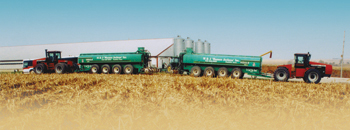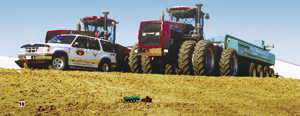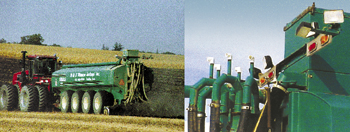
Iowa’s Jim and Mit Skinner are in
the custom application business – with their company the Manure Jockeys
– but they believe they are also in the public relations business, and
are out to build a positive perception of manure applicators.
 |
Iowa’s Jim and Mit Skinner are in the custom application business – with their company the Manure Jockeys – but they believe they are also in the public relations business, and are out to build a positive perception of manure applicators.
The sign on the side of his tanks may say M&J “Manure Jockeys” Inc., but Jim Skinner is also in the public relations business. He wants to change how people perceive custom manure applicators – or at least how they view M&J.
“We try to do the best job we can,” says Jim, who with his wife, Mit, are partners in the Paullina, Iowa, business. “Ninety-five percent of the time, you’ll have a hard time telling we’ve been in a field if you drive down the road.
“But for a two-week period this fall, we couldn’t travel from our house to go to work without driving through manure, and that is sad. It just gives the custom-application business a bad name. I don’t like manure, and the last thing I want to do is drive through it or have other people drive through it. We are highly picky, and I wish it made more of a difference.”
Jim and Mit say they also believe applicators play a critical role in how the public views the hog and cattle industry.
“Having respect for the public is very important and vital to the stigma that surrounds this industry,” Mit says. “If someone sees clean tanks on the roadway rather than those coated with manure, their perception may be different.”
To help maintain both a positive public image and their equipment, Jim and Mit always wash their pumps and pressure wash their tanks, if needed, before leaving sites. As a former nurse, Mit says this also helps reduce the spread of disease from farm to farm.
“When we got into this, pseudorabies was a big thing,” Mit says. “Now that the pseudorabies scare is over, it seems like it’s not a big deal. But there are other things out there.”
Unfortunately, Jim says, not everybody shares their philosophy. Although some of their longtime customers appreciate their penchant for cleanliness, others just look at the cost per gallon when choosing an applicator.
As more people enter the custom application business in northwestern Iowa, the challenge of balancing economics with a positive public image has become more difficult, Jim and Mit say.
“The problem we have in Iowa is you have so many people who think, ‘That looks like fun and look at the amount of money. With a one million gallon lagoon and at one cent per gallon, that’s $10,000,’” Jim says.
“But they don’t see the expenses that are incurred in the long run while doing it. We have seen a lot of people start out and only last a couple of years. They were cutting their rates and getting into the business, and then boom, they aren’t around any more.”
The rates that applicators charge have remained relatively stable at about one cent per gallon or even dipped slightly during the 10 years M&J has been in business. But operating costs continue to rise.
In 1998, for example, M&J paid 67 cents per gallon for farm diesel, Mit says. During the fall of 2006, they paid $2.20 per gallon.
M&J purchased a 9,500-gallon Houle tank for $55,000 six years ago. Jim says he priced the same tank two years ago for $95,000. M&J currently runs two Houle 9,500-gallon tanks, each with a 15-foot folding tool bar and disc incorporators.
Not too long ago, Jim considered switching to knives. But when many producers decided to follow corn with corn this fall to capture high commodity prices, he decided to stick with discs.
“With a knife system, it’s hard at night to see where you’ve been, and they bunch up,” Jim says, referring to the corn crop residue that gets caught. “We have to be versatile so we can go through corn stalks. We did a lot of corn this fall, and knives aren’t as efficient.”
 In a cute twist, below is a small replica (in the foreground) of one of the Manure Jockeys’ tractors and Houle tanks, complete with the same company graphics. In a cute twist, below is a small replica (in the foreground) of one of the Manure Jockeys’ tractors and Houle tanks, complete with the same company graphics.
Photos by Levi Wielenga
|
M&J favors Houle equipment because of its durability and accuracy. Although it may cost more to purchase, Jim says Houle pays off in the long run with reliability.
“It’s expensive equipment, but it’s so accurate,” he says. “Our tanks empty themselves within 10 seconds of each other.”
Each partner has his or her own tank. Jim’s is only six years old and Mit’s is nine years old, but most people can’t tell the difference.
“If you park them side by side, I can tell the difference because I know what to look for,” Jim says. “We do pressure washing. We get brushes out and scrub them down. We acidize them. We wax them. We keep them looking good to keep the value when we go to trade them in.”
M&J pulls the tanks with articulated Case-IH Steiger tractors. They also have several Houle chopper pumps, as well as a 55-foot Houle lagoon pump.
Like many applicators, M&J’s busy seasons are dictated by the weather. They apply in the spring after the ground thaws and dries and before planting. They are also busy during the fall after harvest and before the winter cold freezes the ground.
“It’s best to apply on ground that is normal to dry for the best coverage,” Mit says. “If the ground is too damp or wet, then you compromise the manure coverage. If you’re applying in these conditions, there is also a chance of tracking onto the road and making a mess. This is something we won’t do.”
The Iowa Department of Natural Resources requires all animal feeding operations to submit manure management plans that address nitrogen, phosphorus and potassium levels in relation to crop requirements. The plan also identifies the land areas on which manure will be applied and application methods. The livestock producer is responsible for revising it annually with updated manure sample results.
 In addition to the standard lights that came with the tractors, Jim Skinner added additional lights, on the lower front of the tractors and the upper rear of the tanks, to make the equipment more visible, especially at night. In addition to the standard lights that came with the tractors, Jim Skinner added additional lights, on the lower front of the tractors and the upper rear of the tanks, to make the equipment more visible, especially at night. |
As a new service, M&J will take a manure sample – at their expense – during the application. The results can be used for the producer’s manure management plan.
Jim calculates how fast his applicators should drive, using information from the manure management plan and flow rates from the tank. It takes nine minutes, 45 seconds for a tank to empty.
As confined animal operations have begun to reduce the amount of water used to flush the barns, manure solids and the associated nutrient concentrations have increased. For example, a lagoon from which M&J historically pumped one million gallons now yields only 600,000 gallons, Jim says. The total number of gallons M&J handles also has decreased significantly from 30 million gallons in 2000.
In some cases, the manure consistency has thickened to something similar to chocolate pudding. And agitation has become even more critical to ensure the liquids and solids are well mixed before the material is pumped.
“We take more time to agitate,” Jim says. “Now we’d like to start putting two pumps in each deep pit – not in the lagoons – but in the deep pits under the buildings.”
Applicators also have to apply fewer gallons per acre to achieve the same nutrient levels, which typically means driving faster across the field.
Jim says he has considered buying a Krone flow meter for each tank to improve application accuracy. As the driver speeds up or slows down, the meter adjusts the flow accordingly to maintain uniform applications.
He also has thought about equipping the tanks with GPS. Drawing location data from orbiting satellites, the GPS unit guides the driver to avoid skips or overlaps during application. The unit also records the application, and the information can be downloaded and used to create detailed maps. But at $12,000 apiece, the meters are a sizable investment, Jim says.
“In order to justify that, we will have to raise our rates,” he says. “But they’ll still be right around 1 cent per gallon.”
At one time, M&J served Minnesota and South Dakota in addition to Iowa. But state licensing requirements and increased fuel costs forced Mit and Jim to restrict their business mainly to Iowa.
The Iowa Department of Natural Resources requires each commercial manure application service to be licensed, at a cost of $200. All employees, whether or not they apply manure, also must be certified, at $100 apiece. To be certified, they may take a test, attend a three-hour class or watch a three-hour training video.
“In the state of Iowa alone, this adds a significant, additional cost to every commercial applicator’s business,” Mit says.
Minnesota has a similar certification program and accompanying fees.
At one time, M&J ran 24 hours per day, but Jim and Mit found they had more repairs as maintenance was pushed aside. Now they typically run about 18 hours per day during the busy season.
In addition to Jim and Mit, M&J has one other full-time employee – Levi Wielenga. During the busy season, about six to eight part-timers help them. Jim says he’s fortunate that the same part-time employees have returned the past three years.
“Everyone on our crew has experience,” he says. “They know how the equipment works. They know how to take care of it.”